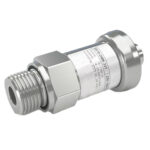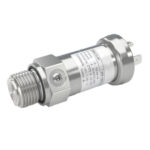This section illustrates Applied Measurements’ range of flush diaphragm pressure transducers that are designed for use where the media is either viscous, contains particulates or solids, or is otherwise liable to block the port of a conventional pressure transducer, with a recessed diaphragm or pressure port. Our flush diaphragm pressure sensors ensure no clogging inside the pressure port.
Read More About Our Flush Diaphragm Pressure TransducersCommon industries include food, pharmaceutical, environmental engineering (water, sewage, recycling), process, industrial and shipbuilding applications.
Optional Ex ia intrinsically safe for gases and dust versions and food process versions are available on some of our models below.
All flush diaphragm pressure transducers can be supplied with digital displays and indicators, signal digitisers, telemetry systems, data loggers and acquisition equipment from our range of transducer instrumentation. Calibration traceable to UKAS standards is available on all pressure sensors and systems.
What is a Flush Diaphragm Pressure Sensor?
A flush diaphragm pressure sensor has a diaphragm flush-mounted at the end of the sensor creating a flat surface across the end of the sensor. This is unlike standard pressure sensors where the sensing diaphragm is inside the pressure sensor within an open bore. There are also semi or quasi-flush designs where the sensing diaphragm sits very slightly back from the front of the pressure port, typically by just 1-2mm, and these offer the same advantages a fully-flush design.
As the sensing diaphragm on a flush pressure sensor is in direct contact with the pressure media, it enables the liquid to flow across it without risk of clogging the sensor. This makes it ideal to use in viscous or pasty media, where a recessed pressure port would be prone to blockages.
Plus, its flush diaphragm design allows for easy cleaning of all the surfaces making it perfect for sterile environments such as hygienic food applications or medial applications, where the sensor needs to be kept sanitary.
Oil-Filled Flush Pressure Sensors vs non-Oil-Filled Flush Pressure Sensors
Oil Filled Flush Pressure Sensors
Oil filled sensors have 2 diaphragms, one inside the cavity of the pressure sensor and one diaphragm flush mounted at the end of the pressure sensor. The internal cavity is filled with oil and when the external flush mounted diaphragm is exposed to the pressure media, the diaphragm puts pressure on the oil within the cavity. This in-turn puts pressure on the internal sensing diaphragm which converts the deformity into an electrical signal.
Temperature can have an effect on the oil inside the bore and several O-Rings are needed to ensure the oil does no leak out from the pressure sensor.
Non-Oil Filled Flush Pressure Sensors
These flush pressure sensors have only one sensing diaphragm and it sits flush with the end of the pressure sensor. The sensing bridge is on the internal side of the diaphragm and the external side is exposed to the pressure media. As the sensing diaphragm is in direct contact with the pressure media, the diaphragms tend to be thicker.
Advantages of a Flush Pressure Sensor
Flush Pressure Sensor Applications
Product Links
Filters
Availability
Media
Output
Environment
Pressure Range
Accuracy
Aggressive Media | *Oxygen Pressure Sensor | DMK331
0-400mbar up to 0-600barFrom £270Buy OnlineFlush Diaphragm Pressure Sensor | P600FD
0-4bar up to 0-400barFrom £272Flush Welded | Flush Diaphragm Pressure Transducer | DMK331P
0-60bar up to 0-400barFrom £326Buy OnlineProcess Industry Pressure Transducer | Flush Welded | DMP331P
0-100mbar up to 0-40barFrom £326Buy Online








